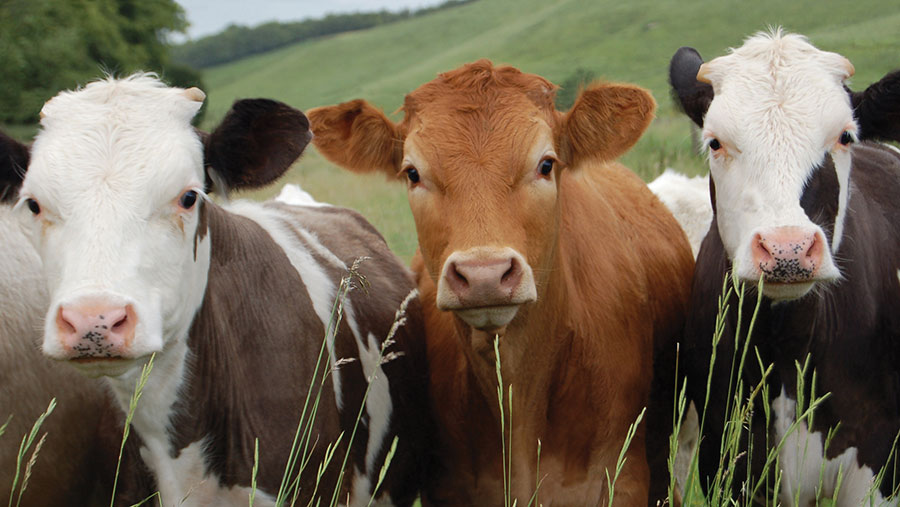Calls for £5/kg as costs rise before beef supplies
 © Adobe Stock
© Adobe Stock Enormous rises in fuel, cereal and fertiliser costs have sparked calls for base beef prices of £5/kg ahead of forecasts of increased cattle availability in the autumn.
Both Ireland and the UK expect prime cattle supply to increase in the second half of the year. This is according to Bord Bia and AHDB, whose forecasts are for annual production to lift 3-4% and 1%, respectively, with both increases happening in the second half of 2022.
Farm advisers expect these increases to coincide with a surge in cull cow and prime beef as fertiliser and cereal prices threaten to have significant effects on forage production and the desire to house cattle. They say if silage stocks are low because of limited fertiliser buying, and fuel and cereal remain expensive, there will be little incentive to carry cattle into winter.
See also: Sexed semen sales double to 63.5% of all dairy semen sales
Will processors get more meat?
Duncan Wyatt, lead red meat analyst at AHDB, said there was to be more meat this year, but the increase in beef-cross dairy calves should not be overwhelming.
“We already get 48% of ‘prime’ animals, including dairy males, from the dairy herd as it is. A few more probably won’t make too much difference,” said Mr Wyatt.
He pointed to registration figures for 2020 showing an extra 27,000 beef-sired animals and 36,000 fewer dairy bulls. In 2021 these figures were 66,000 and 65,000, respectively.
He added that changes in milk company calf policies have only been in place since early 2021, so will have their “modest” impact felt in 2023.
“When we forecast beef production, we normally knock carcass weights down by 1kg per year, to allow for more natives, more beef from dairy, and now, tighter contract specifications, but it rarely seems to turn out this way.
“Farmers have done a great job finishing animals at younger ages throughout Covid, with no material drop-off in carcass weights. High feed costs may have a different impact.”
Finishers say these beef-cross steer carcasses could yield more. Head-to-head an Angus or Hereford steer’s carcass weight is 3-4% greater than a pure dairy steer, with a British Blue-cross being 5-8% heavier on the hook.
SAC beef specialist Basil Lowman said a beef sire typically lifts a dairy calf’s conformation by a grade and gives an improvement in saleable meat yield.
“There are going to be more cattle later in the year and I think there will be a rise in the standard of cattle,” said Mr Lowman.
Can processors give more?
Using a store cattle calculator, Farmers Weekly looked at three finishing scenarios – optimistic, moderate and pessimistic – for a steer/heifer finishing system on straw and barley.
The scenarios used a range of market and performance factors (see table). Costs were split as overheads and feed cost as follows:
- Feed cost: Priced with barley at £260/t feeding 11kg a head a day on average, based on 2.1% intake of liveweight at 85% dry matter
- Overheads: All other costs of bedding, labour and medicines were costed optimistically at £1/day
- Beef price: A hopeful 450p/kg is applied to all cattle.
Three cattle finishing scenarios |
|||
|
Input |
Optimistic |
Moderate |
Pessimistic |
|
Store animal |
£1,000 (227p/kg) |
£1,050 (239p/kg) |
£1,050 (239p/kg) |
|
In weight (kg) |
440kg |
440kg |
440kg |
|
Daily liveweight gain (kg) |
1.55 |
1.3 |
1 |
|
Days on feed |
100 |
120 |
120 |
|
Gain (kg) |
155 |
156 |
120 |
|
Sale weight (kg) |
595 |
596 |
560 |
|
Kill out % |
56 |
54 |
54 |
|
Carcass weight (kg) |
333.2 |
321.8 |
302.4
|
|
Price £/kg |
£4.50 |
£4.50 |
£4.50 |
|
Gross |
£1,499 |
£1,448.28 |
£1,360 |
|
Sale costs |
£32 |
£32 |
£32 |
|
Gross margin |
£467 |
£366 |
£278.80 |
|
Net profit |
£34.98 |
-£153 |
-£226 |
Independent farm consultant Kev Bevan said finishing cattle profitably, given the big jump in grain price, will require good decision-making.
“Above all, you need the right animal,” said Mr Bevan. “Not only one that grows quickly with a good feed conversion rate, but also finishes rather than keeps on growing.
“Speed to a minimum finishing grade will be more important than extra weight if every extra kilo loses money as the animal’s growth rate naturally declines.
“Much, of course, depends on what happens to the finished market price. Given the growing pressure on consumer spending, demand may trump supply in setting the cattle price.”
He stressed that how global beef and fertiliser trade reacts to the Ukraine conflict will be a major pricing factor.
Closer to home, how Irish beef supply responds to these factors will be key, but also how the relationship between Russia, China, Brazil, and the US plays out, said Mr Bevan.
“Ultimately, finishers have an obvious option for squaring the circle: pay less for the store animal. This is not a response cattle rearers want to hear given the pressures on them, too.”
Rise of supermarket cattle
Larger retailers only require R3H or R4L carcasses, which is a job that dairy-bred cattle can do, says Oliver Chapman, auctioneer at Melton Mowbray and Louth.
“We see very few dairy bulls now, which is inevitable because of sexed semen being used on so many herds,” said Mr Chapman. “We see many more Angus and Blue calves now.”
He added that using Friesian or Montbeliarde bulls to breed a beefier, squarer, more robust dairy cow was also improving calf quality.
